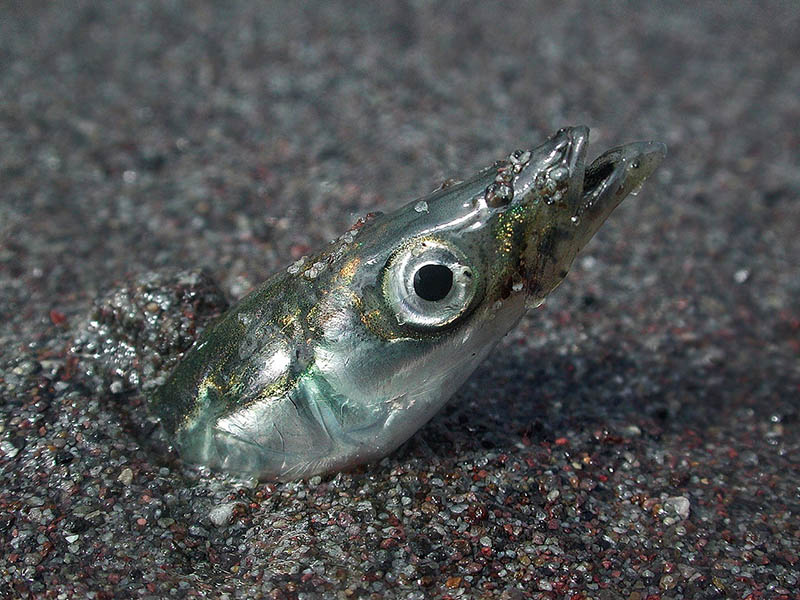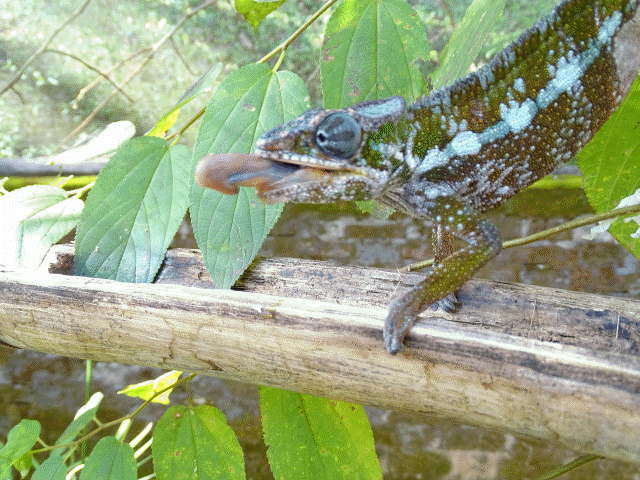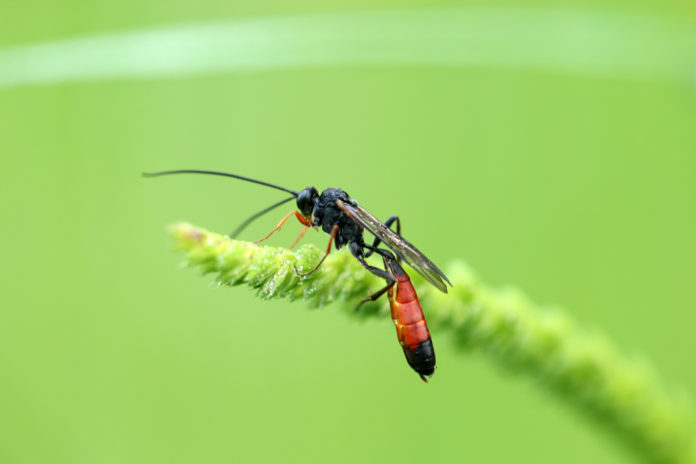The Chameleon’s Amazing Tongue Challenges Evolutionary Paradigm
Chameleons are famous for their ability to change their skin color. However, not all chameleon species share this trait. For those that do, their skin is embedded with cells containing guanine crystals. By changing the space between the guanine crystals, chameleons change the wavelength of light reflected by the crystals, which alters their skin color. Chameleons change their skin color for three different purposes:
- to make social signals to other chameleons
- to alter their body temperature
- to camouflage their bodies when threatened by predators
Other Unique Features of Chameleons
The ability to change skin color is just one of several outstanding body design features that chameleons possess. They also possess the longest tongue-to-body-length ratio of any animal. Some chameleon species can project their tongues out of their mouths to an astounding length that is double that of their bodies (not including their tails)! Chameleons are equipped with an extremely complex set of specialized bones, muscles, and collagenous elements that enable the tongue to be catapulted out to its full length in just 0.07 seconds (see image 1).1 The elastic recoil in the tongue projection mechanism is designed to be relatively insensitive to temperature changes.2 Thus, unlike other reptiles, chameleons can capture prey even when their body temperatures are low.
Image 1: Chameleons’ Elastic Recoil Tongue Projection Mechanism
Gif credit: Wikimedia Commons/SurreyJohn
The machinery controlling the tongue action of chameleons would be useless if it were not for an equally exquisite design of its eyes. Each eye of a chameleon can pivot and focus independently, giving it a 360° arc of vision and the ability to track prey without moving its head. Each eye is independently capable of depth perception (through varying the focus rather than by binocular triangulation) and can accurately track flying insects no matter how fast they are flying. Each eye consists of a negative lens and a positive cornea. Because of this unique telephoto lens system, chameleons possess the highest sight magnification, relative to their body size, of any vertebrate animal.3 There is no limit to how tiny an insect it can grab.
Now, biophysicists have discovered another amazing design feature that chameleons possess. Their tongues are coated with a special adhesive that equips them to capture not just small flying insects but large insects as well.4 This adhesive is a special mucus with a viscosity measure that is 400 times greater than that of human saliva. The combination of the very high viscosity of the mucus coating the tongue, the large contact area the chameleon’s gigantic tongue can make with its prey, and the tongue’s blazingly fast retraction velocity enable chameleons to capture prey that measure a large fraction of their body sizes. This combination of design features in concert with the chameleon’s unique eye designs also explain why chameleons are the only reptiles that, under normal circumstances, never miss their prey.
In Job 38–41, God speaks about how wondrously he designed the lion, the raven, the goat, the deer, the donkey, the ox, the ostrich, the horse, the hawk, the eagle, the hippopotamus, and the crocodile. As I explained in chapters 10 and 12 of my book Hidden Treasures in the Book of Job, each of these creatures stands alone among Earth’s animals in manifesting their marvelous design features. Similarly, the many complex design features of the chameleon really stand out among all Earth’s terrestrial animals. The chameleon has no peer. No other land animal comes close to matching all its exquisite design features

Image 2: Sand Lance Burrowing into Sand to Hide from Prey
Image credit: National Oceanic and Atmospheric Administration
An Ocean Chameleon?
While no other land animal matches its features, a marine animal comes amazingly close to duplicating the chameleon’s tongue and eye designs. That animal is the sand lance fish (see image 2). Like the chameleon, the sand lance possesses eyes that pivot and focus independent of one another and are capable of extreme magnification. Like the chameleon, the sand lance can determine depth perception using a single eye and the eyes can be covered with skin that keeps the eyes from being conspicuous to both predators and prey. Like the chameleon, the sand lance possesses a tongue that can be catapulted out of its mouth at high velocity. Both creatures use the same feeding strategies and techniques.
In a comparative study of the sand lance and the chameleon, three zoologists noted 13 complex morphological designs that the two species share in common.5 Five of the 13 designs are features that are not known to exist in any other fish or lizard species.6 Commenting on just the unique eye designs, the authors wrote,
QUOTE 1
“This is a completely new design principle found only in the eyes of these two vertebrates.”7
QUOTE 2
How the Two “Chameleons” Challenge Evolution
In the same research journal issue another zoologist, in a paper, also commented on the “extraordinary catalogue of convergences between the visual systems of the sandlance and the chameleon.”8 The extraordinary catalogs of convergences that “break all the rules” pose an enormous challenge to models of biological evolution.9
What is the challenge? Actually, there are two. The first is the severe difficulty from an evolutionary perspective of explaining all the amazingly complex, specialized, extreme morphological designs that chameleons possess. The second is the even more severe difficulty from an evolutionary perspective to explain why two species living in radically different environments possess the identical complex, specialized, extreme morphological designs.
Models of biological evolution predict that morphological designs are the product of natural selection. However, the forces of natural selection in the desert environment of chameleons are radically different than the seafloor bottoms of sand lances. Rather, the identical designs that both chameleons and sand lances share provide examples that the more we learn about the universe, Earth, and all the life that Earth contains, the more evidence we establish for the supernatural, superintelligent handiwork of God. Or, as the psalmist declared thousands of years ago,
Endnotes
- Jurriaan H. de Groot and Johan L. van Leeuwen, “Evidence for an Elastic Projection Mechanism in the Chameleon Tongue,” Proceedings of the Royal Society B 271 (April 2004): 761–70, doi:10.1098/rspb.2003.2637; Christopher V. Anderson, Thomas Sheridan, and Stephen M. Deban, “Scaling of the Ballistic Tongue Apparatus in Chameleons,” Journal of Morphology 273 (November 2012): 1214–26, doi:10.1002/jmor.20053.
- Christopher V. Anderson and Stephen M. Deban, “Ballistic Tongue Projection in Chameleons Maintains High Performance at Low Temperature,” Proceedings of the National Academy of Sciences, USA 107 (March 2010): 5495–99, doi:10.1073/pnas.0910778107; Christopher V. Anderson and Stephen M. Deban, “Thermal Effects on Motor Control and In Vitro Muscle Dynamics of the Ballistic Tongue Apparatus in Chameleons,” Journal of Experimental Biology 215 (November 2012): 4345–57, doi:10.1242/jeb.078881.
- Matthias Ott and Frank Schaeffel, “A Negatively Powered Lens in the Chameleon,” Nature 373 (February 1995): 692–94, doi:10.1038/373692a0.
- Fabian Brau et al., “Dynamics of Prey Prehension by Chameleons through Viscous Adhesion,” Nature Physics, published online June 20, 2016, doi:10.1038/nphys3795.
- John D. Pettigrew, Shaun P. Collin, and Matthias Ott, “Convergence of Specialised Behaviour, Eye Movements and Visual Optics in the Sandlance (Teleostei) and the Chameleon (Reptilia),” Current Biology 9 (April 1999): 421–24, doi:10.1016/S0960-9822(99)80189-4.
- Ibid., 421.
- Ibid., 422.
- Michael F. Land, “Visual Optics: The Sandlance Eye Breaks All the Rules,” Current Biology 9 (April 1999): R286–88, doi:10.1016/S0960-9822(99)80180-8.
- The title of the paper is “Visual Optics: The Sandlance Eye Breaks All the Rules.”
- Psalm 104:24.







